First Day Cver – Orchids of Kenya
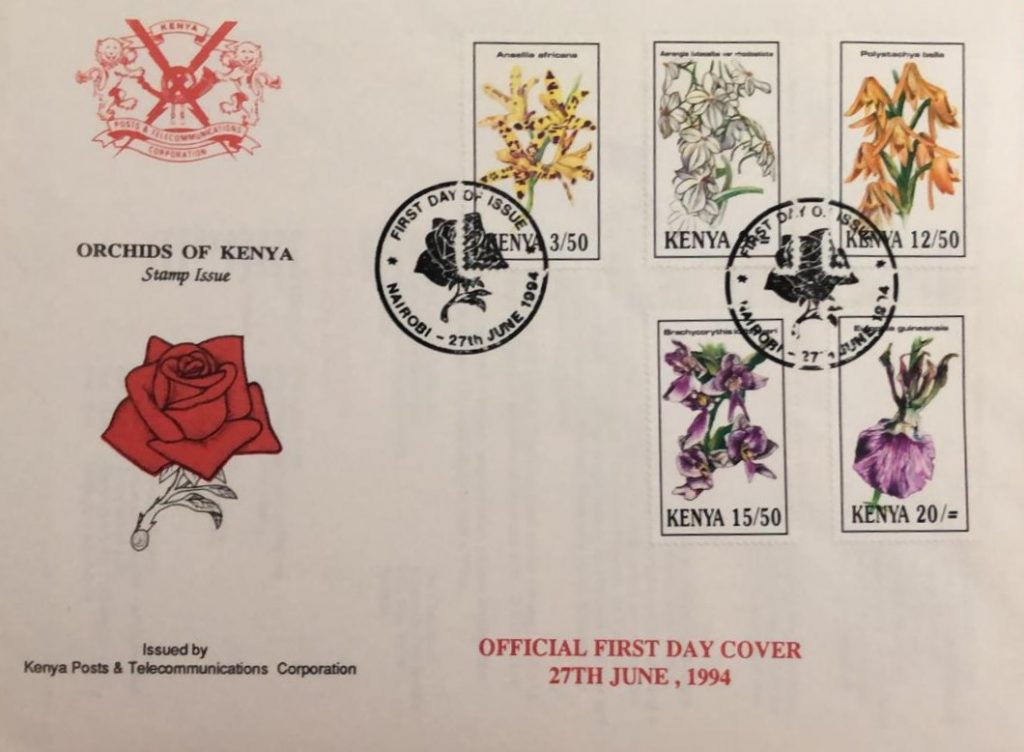
Orchids of Kenya
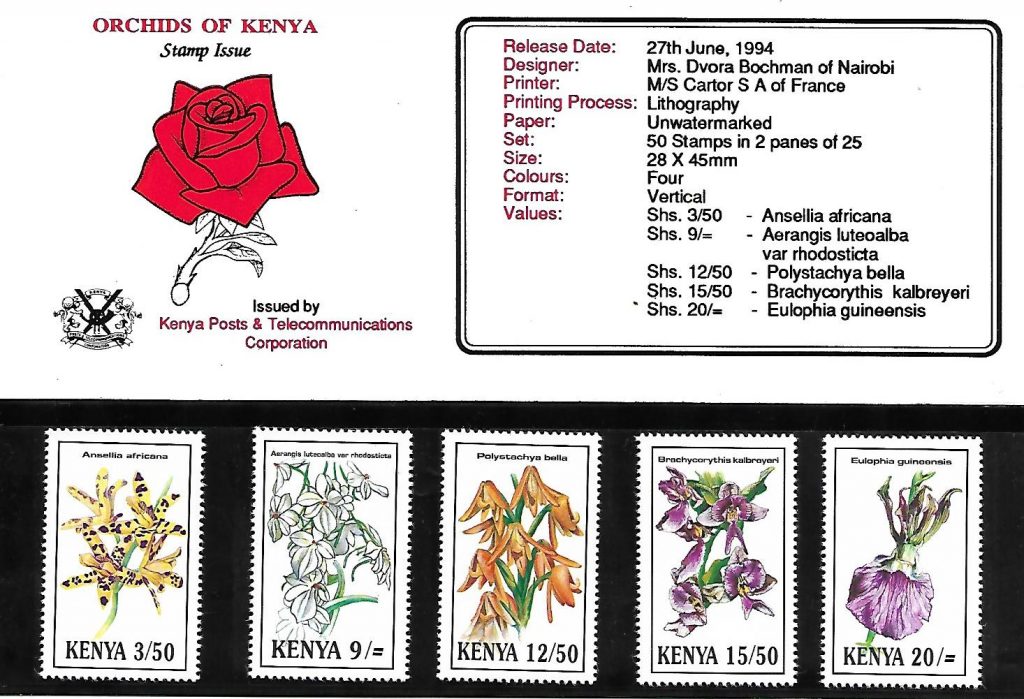
Technical details of the series:
Publication date: June 27, 1994
Designer: Mrs. Deborah Buchman of Nairobi
Printing: M / S Cartor S A from France
Printing process: lithography
Paper: No watermark
Set: 50 stamps in two parts of 25
Size: 28 X 45 mm
Colors: four
Format: Vertical
:Values
Ansellia Africana – 3/50 Kshs
Aerangis Luteoalba var rhodosticta – 9 Kshs
Polystachya bella -12/50 Kshs
Brachycorythis kalbreyeri – 15/50 Kshs
Tuluuhin quinooneie – 20 Kshs

For many years, orchids have provided fascinating subjects for gardening all over the world. Orchids are a diverse and extensive family of plants with beautiful blooms that sometimes excel in fragrant color. They count 28,000 species in 763 genera. Furthermore, since developing tropical species as an agricultural branch in the 19th century, breeders have created more than 100,000 hybrid varieties. Africa is the habitat of thousands of species, and as of Kenya, there are 600 recognized species. Most orchids require distinct types of growing conditions and are, therefore, often affected by environmental changes resulting from tillage, grazing, or deforestation.
A continuous conflict in Kenya between the interests of civilization and the preservation of primeval nature has caused many Kenyan varieties to reach the brink of extinction. The government and the landowners are responsible for maintaining the habitats and the varieties as they are in nature. Obviously, without special attention, the orchids will become extinct. Everyone can contribute to the protection of these beautiful plants. One must be careful to observe them in nature and not collect them despite their beauty.
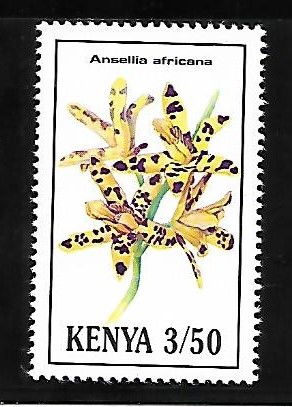
Ansellia Africana (Leopard orchid) 3/50 Kshs
Anselia africana from the orchid family is named after John Ansel, assistant botanist on the 1841 trip to the Niger River, and is known as the Tiger orchid. This species grows on trees in extensive subtropical areas of Africa and, of course, in Kenya. It is mainly found in Kajiado in Ngoroma Hill, Oldunyo Sambo, and Kikambala in Kilifi District. Although the species is more common along the coast, it can also be found in dry and wet habitats at an altitude of 0-200 meters above sea level. The orchid is an “air plant” (epiphytic). That is, the whole plant, including its roots, is above the ground and attached to tree branches. Its needle-like roots are directed upwards and very quickly absorb water and leaf rot from which the plant feeds. In nature, these plants exist for a long time and can reach impressive sizes, making them easy to identify. Their growth will often reach a meter in diameter, and they will rise high among the tree branches. Their weight sometimes exceeds a ton. The plant blooms in the dry winter in clumps of greenish-yellow blossoms sprinkled with brown spots. The number and color of the spots on the petal varies in different regions of Africa. In Kenya, the variety excels in its purple spots on the yellow petals and is particularly spectacular. That’s why it’s named: “Tiger Orchid.” Ansalia Africana is used in traditional medicine as a cure for various diseases. Because of their beauty, they were sold by unscrupulous dealers and found their way into hotels, shopping malls, collections of local orchid enthusiasts, and roadside vendors. Ansalia Africana is used in traditional medicine as a cure for various diseases.
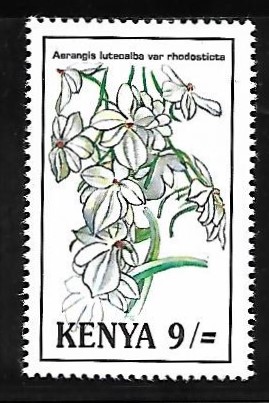
Aerangis Luteoalba var Rhodosticta 9 Kshs
Origin of name: Aerangis Greek: aer = (air) and angos = (urn) luteoalba Latin beige with red spots. The plant was first described and published in the Kew Bulletin in 1979 34, 310.
On its spines, this small and beautiful plant excels in a white flower with a bright red center and is a favorite of all orchid lovers in Kenya and abroad. It excels in flat roots, a very short stem with curved, fleshy leaves – uniform. It blooms in winter or spring. In summer, the plant is in full growth and needs high humidity, lots of water, and fertilizers until mid-autumn, when it should shrink but not to the point of dryness.
Its flowers are fragrant and flat and the inflorescence is 40 cm long. Its growth areas are limited to the central regions of Africa, and it can be found in Kenya in the mountainous moist forests and along dry rivers. Because of the interest in this variety abroad, international trade has caused its growth to decline in the wild. However, there are healthy populations in some protected areas in Kenya. The practice of dispersing the plant from its seeds in the wild and in nurseries has proven successful. The variety is found in the wild, mainly in the Meru district – east of the mountain, in the north of Kisumu, in the forest Kakamega and the Kiricho districts.
It grows in forests at altitudes between 1250 – 2200 meters above sea level, in shady and very humid places as an air plant on twigs and narrow branches, although it also appears on tree trunks. It is often encountered near rivers and waterfalls where the air is humid, but However, it will almost always grow in very shady places. Oddly enough, this is one of those orchids that has adapted well to the man-made habitats of a coffee plantation.
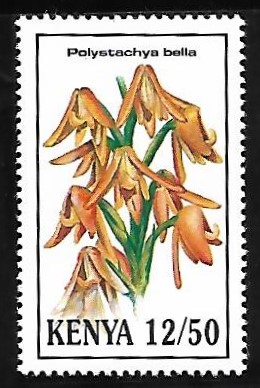
Polystachya bella 12/50 Kshs
Polystachya Bella is a species of Liliopsida and belongs to the genus Polystachya and the orchid family. Common names: the beautiful Polystachia.
There are probably about 20 species of orchids found in Kenya alone; this plant is the rarest of the national endogamous ones. It was first discovered in the Kricho District near Port Ternan, on the Itara River, Changana Tea Estate, in 1929 and was described by Victor Samuel Summerhayes. Since then, a few other sites where it grew up have been registered.
It is a small plant that grows in nature at a height of 15 cm and has a few leaves in bulb-like structures called “pseudobulbs.” Leaves). When the Polystachia blooms, it sends up a group of golden flowers that have made it a favorite among growers.
The inflorescence is hairy and soft and stands out for its flowers and the long, pointed buds, the size and brightness of its golden flowers. The leaf cups and petals are narrow and pointed. Growing the strain from seed in the laboratory was difficult. But in research In the East African Herbarium, a way was found to grow it from seeds.
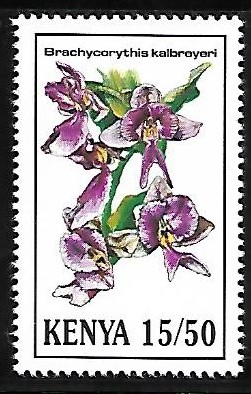
Brachycorythis Kalbreyeri 15/50 Kshs
This fungus belongs to an endemic species of flowering plants from the orchid family.
The variety is now quite common in the equatorial region of Africa. Its habitat is found in rainforests and rivers at altitudes of 1800 – 2100 meters. In Kenya, it appears in the highlands in some moist forests near streams at an altitude above 6,500 meters. This mushroom was first discovered on Mount Cameron and is named after Guillermo Calavier, who identified it. The species is unique in its kind due to its semi-epiphytic growth. Most species of this type grow on the ground, but Brachycorythis Kalbreyeri grows on trees near streams, fallen logs, or damp tree branches.
During the dry season, it will die off, but when the wet season returns, new growth and flowers form. The width of the flowers is 5 cm, and their number will reach up to 15.
The flower cups are white, and the petals are crimson on a white background. The rim shares this color except for the part in front of the column, which changes to a bright yellow. The flowers produce a spicy fragrance.
Now this orchid can be found growing in private collections in Kenya and abroad and produces a handsome flower whose bloom lasts for several weeks with a strange spicy fragrance.

Eulophia Guineensis 20 Kshs
This variety of orchids differs from others in this series due to its growth on the ground. It reaches a height of 65 cm. Its flowers are few and their color is purple and brown. Their growth is upright at the upper end of the stem. They spread a delicate and pleasant fragrance. The variety is common in the African continent, Yemen, and Oman. In Kenya, it grows in the shade of trees in the western provinces and is quite common around Turbo near the Kipkaran River, Kisumu, and South Elgon above Kimilili. This plant can be found in shade or semi-shade between rocks in bushes and forests. At an altitude of between 600 – 2000 meters above sea level.
For more information on orchid conservation, please get in touch with the following institutions for information and advice. East African Herbarium Plant Conservation and Propagation Unit National Museums Kenya P.O. Box 40658 Nairobi. The Chairman Orchid Society of Kenya, P.O. Box 30740 Nairobi.
This interesting series was commissioned by Bochman and received much attention. She liked the subject and even visited orchid displays held in Nairobi.
The beauty of the flowers won her heart. After contacting the Kenya Orchid Society, she contacted Joy Emmett, Heather Campbell, and Diana B. Patel, owner of an orchid nursery on Riverside Drive, who also showed her the variety from which vanilla is made. She also contacted a tribal representative who shared information about the issue with her. It turned out that orchids grow almost everywhere, but the varieties are small to tiny and unidentifiable without specific knowledge of the subject. Therefore their existence is guaranteed.
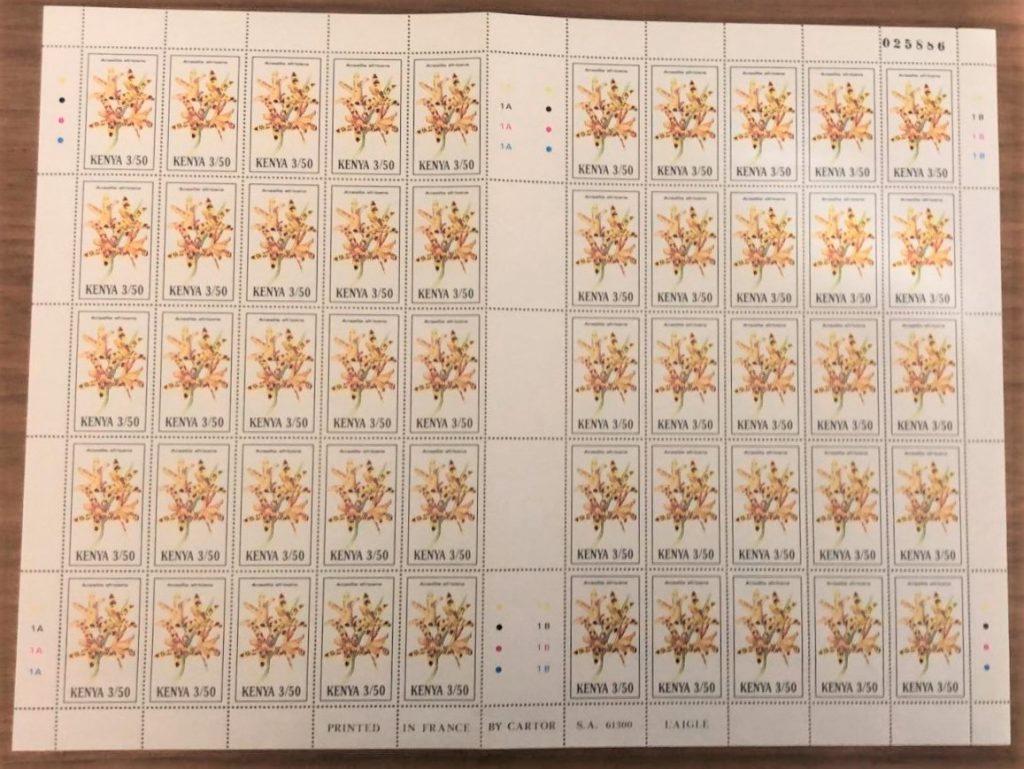
When Zvika returned from abroad, he brought a book, perhaps an encyclopedia, about orchids. It was coveted by an old acquaintance (Puria Fried) who grew orchids. In this way, the artist was prevented from further study before making this series of stamps. Only now, after many years, a book about orchids was returned to the artist.

